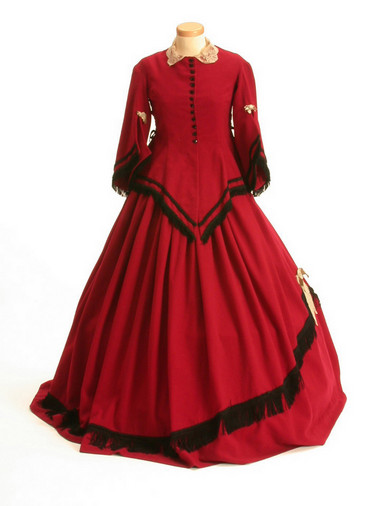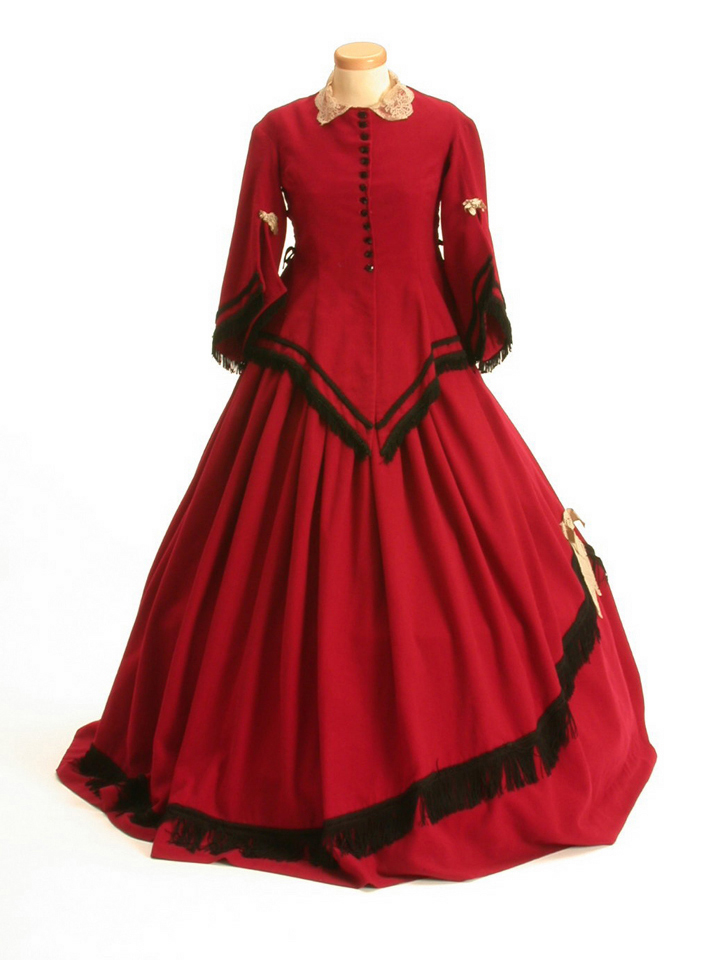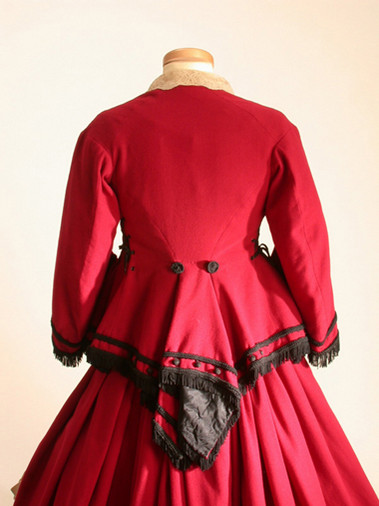Woman's Red Skirt & Bodice, Victorian, Replica
This skirt and bodice is from the middle of the 19th century when
it was usual for tops and skirts to be made of the same fabric so
that the outfit looked like a dress. Skirts had been getting wider
and wider, and by the middle of the century were supported on cages
of light steel called crinolines. These were lighter than layers of
petticoats, and allowed for freer movement. As well as crinolines,
women often still wore some petticoats. They also wore corsets made
of whale-bone. These were laced up very tight to give women tiny
waists.
This garment is a replica and its vivid colour has been achieved with synthetic dyes. However, this colour was also possible in the mid 19th century. In 1856 an 18 year old chemist, William Henry Perkin, accidentally produced the first ever synthetic dye - known as mauveine. Queen Victoria wore a gown dyed with mauveine at the Great Exhibition in 1862. The new vivid colours appeared quite garish and not everyone approved of them. But under harsh electric lighting, the rich, intense colours looked stunning.
This garment is a replica and its vivid colour has been achieved with synthetic dyes. However, this colour was also possible in the mid 19th century. In 1856 an 18 year old chemist, William Henry Perkin, accidentally produced the first ever synthetic dye - known as mauveine. Queen Victoria wore a gown dyed with mauveine at the Great Exhibition in 1862. The new vivid colours appeared quite garish and not everyone approved of them. But under harsh electric lighting, the rich, intense colours looked stunning.

Move your mouse over the image for alternative view.


This skirt and bodice is from the middle of the 19th century when
it was usual for tops and skirts to be made of the same fabric so
that the outfit looked like a dress. Skirts had been getting wider
and wider, and by the middle of the century were supported on cages
of light steel called crinolines. These were lighter than layers of
petticoats, and allowed for freer movement. As well as crinolines,
women often still wore some petticoats. They also wore corsets made
of whale-bone. These were laced up very tight to give women tiny
waists.
This garment is a replica and its vivid colour has been achieved with synthetic dyes. However, this colour was also possible in the mid 19th century. In 1856 an 18 year old chemist, William Henry Perkin, accidentally produced the first ever synthetic dye - known as mauveine. Queen Victoria wore a gown dyed with mauveine at the Great Exhibition in 1862. The new vivid colours appeared quite garish and not everyone approved of them. But under harsh electric lighting, the rich, intense colours looked stunning.
This garment is a replica and its vivid colour has been achieved with synthetic dyes. However, this colour was also possible in the mid 19th century. In 1856 an 18 year old chemist, William Henry Perkin, accidentally produced the first ever synthetic dye - known as mauveine. Queen Victoria wore a gown dyed with mauveine at the Great Exhibition in 1862. The new vivid colours appeared quite garish and not everyone approved of them. But under harsh electric lighting, the rich, intense colours looked stunning.





















